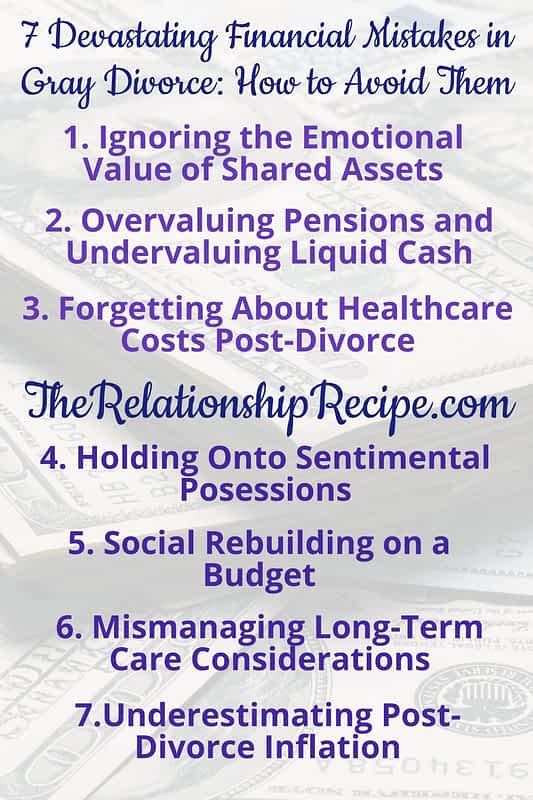7 Devastating Financial Mistakes in Gray Divorce: How to Avoid Them
Divorce after decades of marriage isn’t just an emotional rollercoaster: it’s a financial minefield. When you’re facing a silver split, the stakes are higher than ever, and the financial mistakes in gray divorce can have lasting consequences if you’re not prepared.
Splitting assets after 50 often means dividing retirement savings, adjusting to solo living, and confronting unexpected expenses.
But the real danger aside from the usual gray divorce emotional pitfalls and regrets, there can be unexpected silver linings – however, financial mistakes in a silver divorce that no one sees coming can derail your golden years and leave you struggling to make ends meet.
💡Key Highlights:
- Why the family home might be more of a burden than a blessing.
- The hidden dangers of relying too heavily on pensions or retirement accounts.
- How social isolation can lead to unexpected financial consequences.
- The cost of long-term care that most people overlook.
- A critical aspect of healthcare planning that often gets ignored

This got me to thinking, what are the financial considerations many of us miss when planning and going through a gray divorce? As for myself, I have some financial concerns for my future as a gray divorcee – for instance, I inherited my dad’s hot rod – should I sell it? (See point #4)
This may not be the smartest thing financially, but I can’t let go of his stuff, especially the car. It’s the one thing that I can still feel his presence with, because I watched him pour so much of himself into it over a span of decades.

This is what I do in Dad’s Hot Rod – haha
Luckily, the car is not a daily driver, and the cost to keep it low enough that I can afford to insure it, register it, and keep some gas in it. For these reasons, it seems worth it to keep for now.
So, I get how hard it is to let sentimental stuff go.
I think you might find these 7 points worth considering if you haven’t already.

7 Financial Mistakes in Gray Divorce to Avoid
Breaking free after decades of marriage feels liberating until you realize your finances are circling the drain.
Understanding and dodging the biggest financial mistakes in gray divorce isn’t just smart – it’s survival. If you want to avoid financial ruin in divorce after 50, you’ve got to look past the rose-colored glasses (and the granite countertops).
Here’s how to sidestep some of the most common (and costly) traps:
🚩1. Clinging to the House Like It’s Your Emotional Support Animal
💣The Screw-Up: Plenty of people get laser-focused on the family home. It feels safe. Familiar. But your nostalgia can torpedo your bank account faster than you can say “gray divorce hidden costs.”
💔Why It’s a Problem: Yes, that house is full of memories, but it’s also stuffed with property taxes, sky-high utility bills, and sneaky repairs that love to pop up right when you’re least prepared. If you’re not careful, you’ll end up house-rich and cash-poor.
💡Smarter Move: One of the most common financial pitfalls in gray divorce is refusing to let go of the house without crunching the numbers. Do a clear-eyed cost-benefit analysis. Is it worth the stress just to keep a familiar roof over your head? Or could downsizing be your ticket to a fresh start—and a healthier bank balance?
If selling feels too final, get creative. Turn that place into a rental property to pad your income, or convert part of it into a suite for multigenerational living. That way, you keep a thread of connection without swallowing all the expenses yourself.
👉The bottom line: Prioritize what actually helps you stay solvent. Letting go of the emotional baggage tied to real estate can save you from one of the most painful financial mistakes in a silver divorce.

🚩2. Treating Your Pension Like It’s a Golden Ticket
💣The Screw-Up: Lots of couples think, “We’ll just split the pension 50/50 and call it fair.” That is until you realize pensions don’t magically turn into cash the minute you sign the papers.
💔Why It Hurts: Pensions are all about future income. That sounds comforting until you wake up post-divorce with a stack of bills and exactly zero dollars you can actually spend. If you don’t plan carefully, you’ll be rich on paper and broke in real life – one of those sneaky gray divorce hidden costs no one warns you about.
💡Smarter Move: One of the biggest financial mistakes in a silver divorce is obsessing over pensions and ignoring liquid assets. Yes, your pension will pay out eventually, but you can’t buy groceries or cover moving costs with a promise of future checks.
When you’re hashing out your settlement, think strategically. It might be worth taking a smaller slice of that pension pie if it means walking away with more cash or investments you can tap right now. Liquid assets give you options—like relocating, starting over, or just keeping the lights on without panic.
👉Remember, the goal here is to avoid financial ruin in divorce after 50. Don’t let a so-called “equal split” leave you high and dry when you need money the most.

🚩3. Acting Like Healthcare Magically Sorts Itself Out
💣The Screw-Up: A lot of folks barrel into gray divorce thinking, “I’ll figure out health insurance later.” Unfortunately “Later” usually shows up with a giant bill and a headache you can’t afford.
💔Why It Stings: Once you split, your cozy shared health insurance coverage often disappears faster than your spouse’s toothbrush. If you’re not quite old enough for Medicare, you’re staring down sky-high premiums and out-of-pocket costs that can demolish your budget. Nothing like a little financial ruin in divorce after 50 to keep you up at night.
💡Smarter Move: One of the nastiest financial pitfalls in gray divorce is pretending healthcare costs don’t exist. They definitely do, and they’re not inexpensive.
Get proactive. Start by checking your options on your state’s Health Exchange. Thanks to the Affordable Care Act, you might snag a decent plan with subsidies that won’t gut your savings. If you just need a bridge to Medicare, short-term health insurance can tide you over without completely blowing your budget.
Better yet, think about negotiating healthcare support as part of your divorce settlement. Maybe your ex helps cover your premiums or keeps you on their employer’s plan a bit longer. If COBRA’s on the table, don’t dismiss it – it’s pricey but sometimes the simplest short-term fix.
And don’t forget to open a Health Savings Account or Flexible Spending Account if you qualify. These can ease the sting of medical costs with a little tax relief.
👉Bottom line: Planning ahead keeps you from discovering the hidden costs of gray divorce the hard (and expensive) way.

🚩4. Hoarding Sentimental Stuff Like You’re Running a Personal Museum
💣The Screw-Up: You cling to antiques, fancy artwork, or Grandma’s china cabinet like they’re priceless treasures without ever stopping to ask what they’re actually worth.
💔Why It Drains You: Emotional attachment has a sneaky way of clouding your judgment. You convince yourself those possessions are untouchable, but meanwhile, they’re gobbling up your cash in maintenance, insurance, and storage. That’s a surefire way to stumble into one of the more avoidable financial mistakes in a silver divorce.
💡Smarter Move: One of the biggest financial mistakes in gray divorce is assuming sentimental equals valuable, when it usually doesn’t.
Before you get too attached (or start swearing you’d never part with your “priceless” collection), call in a professional appraiser. They’ll give you a cold, honest number based on what the market actually thinks, and not what your heart does.
Once you know the real value, ask yourself a hard question: If this stuff had no memories attached, would you still keep it? If the answer’s no, it’s probably time to sell or downsize. Cashing out can help you avoid financial ruin in divorce after 50 by shoring up your retirement savings, paying off debt, or covering healthcare costs.
And if you simply can’t let go, fine – but be strategic. Negotiate to keep that antique armoire, but make sure you get compensated with more liquid assets to balance things out.
👉Bottom line: Your memories aren’t going anywhere, but your money will if you let sentiment run the show.

🚩5. Treating Your Post-Divorce Social Life Like a Midlife Spring Break
💣The Screw-Up: You spend decades married, and suddenly you’re free. So you start throwing money at every shiny social distraction: fancy dinners, spur-of-the-moment getaways, overpriced hobbies. You know, to fill the void.
💔Why It Bleeds You Dry: Rebuilding your social life is important, but blowing through your savings isn’t exactly a badge of honor. One of the most overlooked financial mistakes in gray divorce is forgetting to budget for this new chapter. If you don’t watch it, you’ll be left with great memories, and a bank account running on fumes.
💡Smarter Move: You don’t have to sit at home rewatching old sitcoms just because you’re avoiding financial ruin in divorce after 50. But you do need a plan.
Here’s how to keep your social life lively and affordable:
✅ Invest in Smart Memberships
Skip the extravagant clubs. Instead, look into memberships that give you steady, budget-friendly connections; think fitness centers, book clubs, or local art groups. These let you build community without torching your finances.
✅ Use Free Networking Opportunities
Public libraries, community centers, and online groups are packed with free events. Whether you’re into knitting circles or photography meetups, these options help you dodge unnecessary financial mistakes in gray divorce while keeping your calendar full.
✅ Set a “Social Fund”
Treat your social life like any other budget line. Decide exactly how much you can spend on fun each month, and stick to it. That way, grabbing coffee or seeing a play won’t derail your bigger financial goals.
✅ Leverage Volunteering
Volunteering does double duty: it reconnects you with purpose and people. From mentoring to helping out at the food bank, you’ll build a fresh network without spending a dime, and you’ll avoid those sneaky gray divorce hidden costs.
✅ Explore Affordable Travel
You can absolutely scratch the travel itch without maxing out your credit card. Look into group tours or senior travel clubs offering discounted rates. You’ll meet new faces, make memories, and still have money left over for retirement.
👉Bottom line: Rebuilding your social life shouldn’t mean wrecking your finances. Get strategic so you don’t look back and realize your “new start” came with an epic credit card bill.

🚩6. Pretending Long-Term Care Is a Problem for “Future You”
💣The Screw-Up: You breeze through the divorce thinking, “I’ll figure out elder care later.” Newsflash: Later has a habit of arriving sooner—and uglier—than you expect.
💔Why It Wallops You: Divorce doesn’t just split your assets; it also shatters any plan you thought you had for aging. One of the most brutal financial mistakes in gray divorce is assuming someone (a child, a sibling, your ex, the universe) will swoop in to handle your care. Spoiler: They probably won’t.
If you ignore this reality, you could wind up stuck in an overpriced care facility, draining your retirement savings until there’s nothing left but regret and hospital invoices. That’s the kind of gray divorce hidden cost that can wreck your golden years.
💡Smarter Move: Let’s get proactive before you need help getting out of bed.
✅ Invest in Long-Term Care Insurance
Buying long-term care insurance may not sound glamorous, but neither does blowing your nest egg on assisted living. This coverage helps pay for in-home care or facility costs so you’re not left scrambling—and broke—when the time comes. Avoiding financial ruin in divorce after 50 means thinking ahead, even if it feels awkward.
✅ Consider Co-Housing with Friends
Who says you have to go it alone? Co-housing with friends or like-minded folks can slash expenses. You can pool resources for healthcare, groceries, and house maintenance while also building a supportive mini-community. It’s a smart way to dodge one of the biggest financial mistakes in a silver divorce while keeping your independence intact.
👉Bottom line: Don’t stick your head in the sand and hope for the best. Long-term care planning now is the difference between comfort and chaos later.

🚩7. Acting Like Inflation Is Just Some Distant Theory
💣The Screw-Up: You map out your post-divorce budget like prices will stay frozen forever, blissfully ignoring the fact that everything, from groceries to healthcare, gets more expensive over time.
💔Why It Blindsides You: One of the most common financial mistakes in gray divorce is underestimating the slow, relentless creep of inflation. You might feel secure today, but if you’re living on a fixed income, rising costs can quietly torch your savings until you wake up wondering where all your money went. If you want to avoid financial ruin in divorce after 50, you have to plan for tomorrow’s prices – not just today’s.
💡Smarter Move: You can’t stop inflation, but you can outsmart it. Here’s how:
✅ Invest in Inflation-Protected Assets
Don’t just park all your money in cash and hope for the best. Look into inflation-protected investments like Treasury Inflation-Protected Securities (TIPS). These government-backed bonds adjust with inflation, so your nest egg grows along with rising costs. That way, you’re not left clutching a dwindling pile of dollars when expenses spike.
✅ Build an Inflation Buffer Into Your Budget
One of the most overlooked financial pitfalls in gray divorce is failing to pad your budget for future price hikes. Do yourself a favor: create an inflation buffer. This is basically a cushion of extra funds earmarked for the day your grocery bill doubles or your electricity costs skyrocket. It’s not glamorous, but it’s a lot better than panicking when your budget can’t keep up.
👉Bottom line: Inflation isn’t an abstract concept; it’s a guaranteed reality. If you want to protect your financial security and dodge the hidden costs of gray divorce, you have to plan like prices will rise. Because they absolutely will..

Final Thoughts on Avoiding the Financial Pitfalls in Gray Divorce
Navigating a late-life divorce isn’t exactly a walk in the park. But if you sidestep the most common financial mistakes in gray divorce, you’ll be way ahead of the game. Whether it’s mismanaging long-term care, ignoring the hidden costs of a silver divorce, or pretending inflation won’t come knocking, these pitfalls can quietly drain your savings and derail your plans.
Avoiding financial mistakes in gray divorce isn’t about being perfect – it’s thinking ahead, setting clear priorities, and building a budget that actually works in the real world. With a little planning and a lot of honesty about what you need, you can create a future that’s not just secure but genuinely fulfilling.
👉Disclaimer
The information provided in this article is for informational purposes only and should not be considered financial, legal, or tax advice. Readers are encouraged to consult with qualified professionals regarding their specific circumstances. The author and publisher are not responsible for any outcomes resulting from the use of this information. Always seek personalized advice to address your unique needs and goals.

…..
FAQ: Commonly Overlooked Financial Mistakes in Gray Divorce
1. What are common overlooked financial mistakes in gray divorce?
Overlooked financial mistakes in gray divorce include mismanaging assets, underestimating long-term care, and ignoring inflation’s impact on retirement savings.
2. How can I avoid financial mistakes in gray divorce?
To avoid financial mistakes in gray divorce, plan for long-term care, protect assets, and account for inflation’s impact on fixed income.
3. What is the best way to plan financially during gray divorce?
Focus on budgeting, investing in inflation-protected assets, and reviewing long-term care options to prevent financial mistakes in gray divorce.
4. Why is budgeting important in gray divorce?
Proper budgeting helps avoid common financial mistakes in gray divorce by ensuring you plan for unexpected costs, inflation, and future financial needs.
5. Can inflation affect my financial planning after gray divorce?
Yes, underestimating inflation can lead to financial mistakes in gray divorce, especially if you’re relying on fixed income sources like retirement savings.
6. How can I protect my retirement savings after gray divorce?
Invest in inflation-protected assets and create a flexible budget to avoid financial mistakes in gray divorce that could deplete your retirement savings.

This post may contain affiliate links. I earn from qualifying Amazon purchases at no extra cost to you. This content is for informational purposes only and is not a substitute for professional advice. [Read full disclaimer.]
Thank you for reading this post, don't forget to subscribe!







